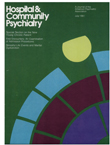The New Chronic Patient: Clinical Characteristics of an Emerging Subgroup
Abstract
A subgroup of chronic mentally ill persons who have bad little or no state hospitalization and who are difficult to engage in existing systems of community care is emerging in major urban areas. Observations made at a large municipal general hospital indicate the patients are typically young, more likely to be male, and highly transient. They have frequent interactions with emergency psychiatric and crisis units, coupled with intermittent involuntary short-term stays in local inpatient units. They have few skills and virtually no natural support systems. Under stress they show disorders in reality testing, exhibit anger and depression, and are prone to impulsive aggressive and self-destructive behaviors. They are typically unwilling to voluntarily accept continuing care. There is a lack of fit between this group's characteristic style of interaction and existing community-based programs. The costs of this lack of fit, both in staff morale and inappropriate use of expensive services, make the exploration of approaches to these "new chronic patients" a matter of immediate importance.
Access content
To read the fulltext, please use one of the options below to sign in or purchase access.- Personal login
- Institutional Login
- Sign in via OpenAthens
- Register for access
-
Please login/register if you wish to pair your device and check access availability.
Not a subscriber?
PsychiatryOnline subscription options offer access to the DSM-5 library, books, journals, CME, and patient resources. This all-in-one virtual library provides psychiatrists and mental health professionals with key resources for diagnosis, treatment, research, and professional development.
Need more help? PsychiatryOnline Customer Service may be reached by emailing [email protected] or by calling 800-368-5777 (in the U.S.) or 703-907-7322 (outside the U.S.).



